New Chromatography Columns and Accessories at Pittcon 2011: Part I
LCGC North America
A review of the liquid chromatography columns and accessories for analytical and preparative chromatography to be unveiled at Pittcon 2011
Part I of our annual review of new products introduced at Pittcon covers all types of liquid chromatography columns and accessories for analytical and preparative chromatography. Next month, Part II will review gas chromatography columns, sample preparation products, and hardware, accessories and small tabletop instruments, mainly for sample preparation.
The Pittcon 2011 Conference and Expo (more formally known as the 62nd Pittsburgh Conference on Analytical Chemistry and Applied Spectroscopy) will return to the Georgia World Congress Center in Atlanta March 13–18, 2011, after a 13-year hiatus. This year's event will host nearly 800 instrument manufacturers and laboratory suppliers in more than 1700 booths. In addition to attending the exposition, conferees will have the opportunity to listen to around 1800 technical presentations (orals, posters, workshops, and invited and contributed talks and award symposia), check out numerous company seminars, and attend one of 146 short courses.
Although attendance has been shrinking the last several years, Pittcon clearly remains the most important yearly international analytical exhibition, where companies introduce their latest instruments, instrument accessories, software, columns, sample preparation, and other consumable products. Because many past attendees have purchased one or more new products within three months after attending the show, most exhibitors attempt to maximize their booth traffic to meet as many potential customers as possible.
The purpose of this report is to summarize many of the new separation consumables and accessory products that will be displayed at Pittcon 2011. In some cases, products that were introduced last year but after Pittcon 2010 (1,2) may be included for reasons of completeness. The information that appears here is based on manufacturers' responses to a questionnaire mailed in late 2010. Because of space limitations and the fact that some manufacturers did not respond to the questionnaire, this report cannot be considered an exhaustive listing of all new products introduced in Atlanta. Over the years, however, these Pittcon introduction summaries have provided a good source of information that would be difficult for one individual to gather during the four days of the exhibition. In addition, the products introduced have shown definite correlations to current research, development, and application activity in the separation sciences.
As in previous years, columns and other products recommended by their manufacturers primarily for biomolecule separations or sample preparation are denoted in the tables with the designation BIO. Some of these products may be used for general high performance liquid chromatography (HPLC) separations as well, but their main emphasis is for biological samples.
In this month's coverage, I describe new introductions in the areas of high performance liquid, reversed-phase, normal- and bonded-phase, ion-exchange and ion, size-exclusion, large- and preparative-scale, and specialty chromatography columns. Next month, I will look at gas chromatography (GC) columns, sample preparation products, and hardware, accessories and small tabletop instruments, mainly for sample preparation.
Trends and Highlights
General: This year, I observed a continuing trend in high-throughput chromatographic and sample preparation techniques and the introduction of more products with inert surfaces driven by the increasing use of tandem mass spectrometry (MS) techniques, which pushes sensitivity to the limits. In HPLC, there will be a further increase in columns and accessories designed to work with ultrahigh-pressure liquid chromatography (UHPLC) products. Many application-specific columns for HPLC and GC will be shown as well as more very-high-temperature GC column introductions. A considerable number of new accessories, hardware, and devices to make the chromatographic laboratory more productive also will be introduced at Pittcon.
HPLC columns: Companies at Pittcon 2011 will offer more sub-2-µm columns for UHPLC; more than 30 companies now have these high efficiency columns in their portfolios. Additional superficially porous particles will appear, giving hope to those chromatographers who aren't ready to invest in UHPLC. Hydrophilic interaction chromatography (HILIC) for the separation of polar compounds weakly retained or unretained by reversed-phase chromatography again will be prominent. Still, reversed-phase HPLC should maintain its dominance. This year, however, we will see an unusual number of new ion-exchange and ion chromatography columns and size-exclusion chromatography (SEC) columns with applications for the separation of monoclonal antibodies and proteins noted. More polymer-based columns will be among this year's introductions.
GC and supercritical fluid chromatography: GC column introductions will be dominated by application-specific columns that are dedicated and tested for a particular class of compounds. Supercritical fluid chromatograpy (SFC) has been getting more attention and this "intermediate" separation technique is catching on, especially in the pharmaceutical area. Packed SFC columns are more like HPLC columns but have some unique phases not found in a typical LC laboratory.
Sample preparation: With a continuing trend, polymeric solid-phase extraction (SPE) phases will represent a majority of the products seen this year. Water-wettable polymeric phases that can dry out during operation and still have good experimental reproducibility and recovery will be more widely available. In addition, they offer mixed-mode mechanisms for more effective cleanup. QuEChERS (quick, easy, cheap, effective, rugged, and safe) is still catching on and will soon be the favored sample preparation technique for pesticides in fruits and vegetables, and it is quickly expanding to new compound classes in new matrices as well.
Accessories: Nearly 40 new hardware products and accessories for HPLC, UHPLC, GC, and sample preparation will be introduced. UHPLC-specific products with higher pressure ratings and with decreased dead volumes will be shown. GC-oriented products include purge and trap, headspace, gas generators, and inert inlet liners, seals, and connectors. Many sample preparation accessories such as evaporators, concentrators, grinding mills, QuEChERS equipment, filtration, pipettors, and digestors will be introduced at Pittcon 2011.
New Series of HPLC Columns and Packings
Each year manufacturers introduce entire new families of HPLC columns at Pittcon. For the sake of brevity, I have elected to cover those series here instead of listing each column under individual headings in the tables. In some cases, the series are extensions of existing products but cover additional phases, whereas in other cases the families are entirely new to the market.
New series of HPLC columns will be shown by several companies (Table I). With a wide range of particle sizes (made by the same process and chemistry) from UHPLC to preparative, seamless scaleup and scaledown within a family is possible. Method development can be performed on a short, fast, analytical column and then can be scaled up to preparative dimensions with easy method transfer. Most introductions of new series will include both sub-2-µm and larger particle versions.

Table I: New series of HPLC columns
It seems like UHPLC is here to stay; most new column introductions will have at least one sub-2-µm particle size in its family. The obvious advantage of such small particles is better column efficiency so that shorter columns can be used to accomplish the same separation that can be achieved on a longer column. The end result is that separation times are greatly decreased in proportion to the column length reduction. In addition, shorter columns with the same internal diameter run at the same flow rate save a proportional amount of solvent, always important these days with the cost of everything on the rise.
At HPLC 2010 in Boston (4), Waters (Milford, Massachusetts) introduced charged surface hybrid (CSH) particles in which a small percentage of positive charge is introduced into the surface layer before bonding the stationary phase. This process was developed to improve peak shape for bases at low pH and to overcome the slow equilibrium when the materials are exposed to alternating high- and low-pH mobile phases, particularly those mobile phases useful for LC–MS. The columns also offer additional selectivity choices. The columns will be featured for the first time at Pittcon 2011 in both a sub-2-µm version and larger particle versions for traditional HPLC work. Figure 1 shows a chromatographic comparison under the same chromatographic conditions for three different ACQUITY reversed-phase columns with C18, phenyl-hexyl, and fluorophenyl functionalities. Having a suite of columns with different selectivities available is important in method development because any given column may not give optimum selectivity. In their white paper on the technology, Waters introduced a new term called the "selectivity factor" (S-value), which is a method to demonstrate the orthogonality of stationary phases (3).
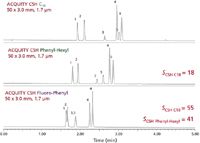
Figure 1: Stationary phase selectivity differences for separation of nonsteroidal anti-inflammatory drugs. Mobile phase A: water; mobile phase B: acetonitrile; mobile phase C: 2% formic acid in water; gradient: 70:20:5 A:B:C to 15:80:5 in 5 min, then 15:80:5 to 0:95:5 in 1 min, then 0:95:5 to 70:25:5 in 0.1 min, then 70:25:5 hold for 3.9 min; curve: 6; flow rate: 1.2 mL/min; injection volume: 10 µL; sample diluent: water; column temperature: 30 °C; wash solvent: 50:50 waterâacetonitrile; purge solvent: 50:50 waterâacetonitrile; detection: UV absorbance at 270 nm; sampling rate: 20 points/s; filter time constant: 0.1 s; system: ACQUITY UPLC H-Class with ACQUITY UPLC photodiode array detector. Peaks: 1 = tolmetin (10 µg/mL), 2 = naproxen (10 µg/mL), 3 = fenoprofen (10 µg/mL), 4 = indomethacin (10 µg/mL), 5 = ibuprofen (100 µg/mL), 6 = diclofenac (10 µg/mL). (Courtesy of Waters Corp.)
Agilent Technologies (Santa Clara, California) has extended its line of Rapid Resolution High Definition (RRHD) UHPLC columns by introducing new phases and dimensions. The RRHD columns can withstand pressures up to 1200 bar.
Reversed-Phase Chromatography
As usual, many new reversed-phase columns will be introduced at Pittcon 2011 (see Table II). This Pittcon will add more than 42 new reversed-phase columns to the huge numbers that already existed from past introductions. Silica-based bonded phase columns will dominate the introductions again this year (~90%) but polymer-based, a polymer-encapsulated silica, organic-silica hybrids, and a silica hydride column also will be on the scene.

Table II: Reversed-phase chromatography
The C18 (octadecylsilane) functionality again will be the most popular with 40% of all reversed-phase columns being this alkyl phase. However, this phase isn't always the optimum for all separations and C2, C4, C8, C30, phenyl, phenyl-hexyl, fluorophenyl, diphenyl, mixed-mode, pentafluorophenyl (PFP), and cyanopropyl phases will be made available by various suppliers to present selectivity alternatives. Several PFP columns will be introduced this year. These columns provide a somewhat different selectivity than typical alkyl reversed-phase columns due to the presence of C-F bonds that provide strong dipole potential. An interesting mixed-mode phase consisting of PFP and C18 also will be introduced. The HILIC columns that have some hydrophobic interaction possibilities will be discussed in the Specialty column section of this column installment.
In keeping with the trend noted in the last few Pittcons, Table II shows a number of introductions of small particle columns in the 2-µm and sub-2-µm range, often referred to as UHPLC columns. There are now more than 30 manufacturers of these high efficiency columns. One of the latest entries in the sub-2-µm category from ES Industries (West Berlin, New Jersey) is the Epic C18 MS 1.8-µm column. Figure 2 shows a chromatogram of a number of neutral compounds obtained using a high percentage of organic modifier in the mobile phase. Such high organic mobile phase conditions are favored by analysts in reversed-phase chromatographic trace analysis requiring high sensitivity MS detection. The Epic phase has a very high bonding density that provides the maximum stationary phase interaction.
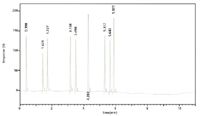
Figure 2: Separation of neutral compounds using a sub-2-µm column. Column: 100 mm à 2.1 mm, 1.8-µm Epic C18 MS; mobile phase A: water; mobile phase B: acetonitrile; gradient: 40% B for 1 min, 40â90% B in 7 min, 90% B for 2 min; oven temperature: 40 °C; detection: UV absorbance at 254 nm; injection volume: 1 µL; flow rate: 800 µL/min; pressure: 750 bar. Elution order: caffeine, ethyl paraben, dimethyl phthalate, diethyl phthalate, toluene, o-xylene, propylbenzene, tert-butylbenzene, anthracene. (Courtesy of ES Industries.)
At Pittcon 2011, additional superficially porous particle (SPP) columns will be displayed. These columns, also referred to as "core shell" or "poroshell" columns, have generated interest in the last couple of years because they give the high efficiency of the sub-2-µm columns yet display about one-half of the pressure drop when operated under similar conditions. This lower pressure is a result of their particle size being in the 2.6–2.7 µm range. The higher efficiency results from a combination of shorter diffusion path lengths and a narrow particle size range that favors the "A" term in the van Deemter equation via very homogenous packing. Figure 3 depicts a separation of sulfonylureas on a HALO PFP phase (Advanced Materials Technology, Wilmington, Delaware). Sulfonylureas are antidiabetic drugs. The separation takes place in less than a minute at a low pressure of 200 bar.
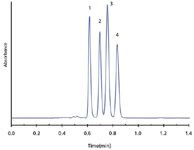
Figure 3: Rapid separation of sulfonylureas on a superficially porous particle column. Column: 50 mm à 4.6 mm HALO PFP; mobile phase: 70:30 methanolâ20 mM sodium phosphate (pH 3); flow rate: 1.5 mL/min; temperature: 30 °C. Peaks: 1 = chlorpropamide, 2 = acetohexamide, 3 = glipizide, 4 = tolazimide. (Courtesy of Advanced Materials Technology.)
In recent years, there has been a trend in introductions of bonded silica-based columns with wider pH limits. Most bonded-phase silicas are recommended to be used in the pH 2–8 range. At low pH (<2), the bonded phase, especially those with short chain lengths, will hydrolyze, leaving behind bare silica. Consequently, retention times will generally change and peak tailing becomes a big problem. At high pH (>8), the silica gel itself will begin to solubilize; this effect is dependent on the solvent, type of buffer, and temperature. By bonding carbon phases with sterically protecting groups, with high coverage of long alkyl groups, or by coating the silica with polymeric material, the pH range can be extended. By using organo-silica hybrid chemistry, bidentate bonding, and polymer-coatings or -encapsulation, the range can be further extended to pH 1–12. This year, columns with an extended range of pH stability will be introduced. Of course, polymeric columns have an even wider range, but still don't rival silica-based columns in terms of efficiency.
Ion-Exchange and Ion Chromatography
Besides the ion-exchange columns to be introduced as part of a family (Table I) or as a specialty column, a larger than normal number of ion-exchange introductions will be made at Pittcon 2011. Most are polymer-based, but one silica-based ion-exchange column will be introduced. Polymer-based ion-exchange and ion chromatography columns have become more popular in recent years because they are more rugged than those based on silica.
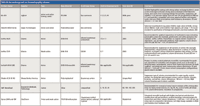
Table III: Ion-exchange and ion chromatography columns
As can be seen in Table III, most of the columns were application-specific. For many such columns, operating conditions have been worked out, minimizing time spent on method development. For example, EPA Method 317.0 rev2 is a method for inorganic oxyhalides in drinking water and other water samples by anion chromatography with conductivity detection and trace bromate using postcolumn derivatization. Dionex (Sunnyvale, California) and Showa Denko (New York, New York) have both come up with columns well suited for this assay. The Dionex solution is based on a monolith column while the Showa Denko application uses traditional 3-µm polymeric packing. Figure 4 depicts the separation of halide, oxyhalides (including bromate), and other anions on the 3-µm Shodex IC SI-35 AD anion-exchange chromatography column. The company's previous 5-µm column required 30 min to accomplish this separation, but for the new 3-µm column, the column length was able to be shortened, resulting in a separation time of only 15 min. The column exhibited more than 12,000 plates for sulfate in this isocratic analysis. In addition, solvent consumption was proportionally decreased (by 40%).
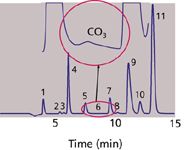
Figure 4: Separation of halides, oxyhalides, and other anions using a small-particle anion-exchange column. Column: SI-35 AD; eluent: 3.6 mM sodium carbonate; flow rate: 0.6 mL/min; temperature: 45 °C; injection volume: 20 µL. Peaks: 1 = Fâ (2 mg/L), 2 = ClO2â (1 mg/L), 3 = BrO3â (1 mg/L), 4 = Clâ (10 mg/L), 5 = NO2â (5 mg/L), 6 = CO32â (300 mg/L), 7 = Brâ (10 mg/L), 8 = ClO3â (1 mg/L), 9 = NO3â (30 mg/L), 10 = PO43â (15 mg/L), 11 = SO42â (40 mg/L). (Courtesy of Showa Denko America.)
Another popular application area this year is the separations of biomolecules such as monoclonal antibodies by anion-exchange and SEC. Columns for monoclonals are covered here in ion exchange but also in the SEC (Table IV) and specialty (Table V) column sections.

Table IV: Size-exclusion columns
Size-Exclusion Chromatography
In the past few years, only a few new SEC columns have been introduced at Pittcon. That doesn't mean that SEC is not a highly practiced separation mode. It is a standard technique for the separation and characterization of organic polymers, both organic- and water-soluble. In addition, the mode is widely used for the separation of proteins and other biopolymers, sometimes known as gel filtration chromatography. In fact, six companies are planning to introduce columns for SEC at Pittcon 2011. The majority of the columns are recommended for the separation of biomolecules but some can be used for nonbiological water-soluble polymers too.
The columns recommended solelyfor water-soluble polymers are those in the TSKgel SuperMultipore PW series (Tosoh Bioscience, Montgomeryville, Pennsylvania), which have various molecular weight operating ranges. The Tosoh scientists have been able to synthesize monodisperse particles that contain multiple pores on the same particle such that one particle exhibits a broad range of pore sizes. Each particle, by design, has an extended linear calibration curve, thereby diminishing the appearance of chromatograms with inflection points. Three semi-micro columns cover a large molecular mass range from oligomers to high molecular weight water-soluble polymers. The smaller particle size of the SuperMultipore PW packings combined with smaller column internal diameter and reduced length permit faster separations with reduced solvent consumption compared to conventional SEC columns.
The TSKgel SuperOligoPW column is based on similar technology but is optimized for the determination of molecular mass of aqueous oligomers, particularly oligosaccharides. Figure 5 shows a high-speed analysis of maltose oligomers comparing this newer column to the larger particle version. The faster analysis results from the smaller dimensions (150 mm × 6.0 mm vs. 300 mm × 7.8 mm for the TSKgel G-OligoPW column) and the smaller particle size (3 µm vs. 7 µm).
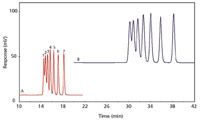
Figure 5: Comparative separation of maltose oligomers using aqueous size-exclusion columns. Column A: 15 cm à 6.0 mm à 4 TSKgel SuperOligoPW; column B: 30 cm à 7.8 mm à 4 TSKgel G-Oligo-PW; mobile phase: water; flow rate A: 0.6 mL/min; flow rate B: 1.0 mL/min; detection: refractive index; temperature: 40 °C; injection volume A: 10 µL; injection volume B: 50 µL. Peaks: 1 = maltoheptose, 2 = maltohexose, 3 = maltopentose, 4 = maltotetraose, 5 =maltotriose, 6 = maltose, 7 = glucose. (Courtesy of Tosoh Bioscience.)
Specialty HPLC Columns
Specialty columns are HPLC columns that have been developed for specific separations that are difficult to achieve on a standard column. However, sometimes manufacturers will use a standard column but test it specifically for a certain class or compounds and provide a recommended set of chromatographic conditions. In some cases, the specialty column comes as part of a "total solution" kit with reagents, standards, and a method. Most specialty columns are delivered with a test chromatogram from an analysis performed at the factory before shipment and some are guaranteed for a specific separation. Table V shows the 14 specialty columns that will be presented at Pittcon 2011. Silica gel–based columns dominate the planned introductions but a polymer-based specialty column and a hybrid column also will be introduced.
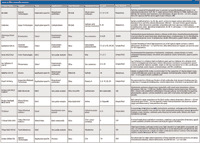
Table V: HPLC specialty columns
As depicted in Table V, three main areas dominate the specialty column introductions: proteins (particularly monoclonal antibodies), HILIC, and chiral. The monoclonal antibody columns are mostly based on polymeric nonporous cation-exchange particles but affinity separation media also have been used. For many years, the study of monoclonal antibodies has been a hot area for the potential development of biopharmaceuticals for diagnostics and clinical use; several monoclonal antibody–based drugs have been approved by the U.S. Food and Drug Administration. Figure 6 shows the separation of monoclonal antibody acidic and basic variants on the nonporous 250 mm × 4 mm Dionex MAbPac SCX-10 polymeric column using gradient elution. This column is packed with strong-cation-exchange particles designed specifically for this important analysis. It is recommended for characterization and quality control assessment of monoclonal antibody variants.

Figure 6: High-resolution analysis of monoclonal antibody acidic and basic variants on a strong-cation-exchange column. Column: 250 mm à 4 mm MAbPac SCX-10; eluent A: 20 mM MES plus 60 mM sodium chloride (pH 5.6); eluent B: 20 mM MES plus 300 mM sodium chloride (pH 5.6); gradient: 15â36.44% B in 50 min; temperature: 30 °C; injection: 50 µg; sample: MAb, 5 mg/mL; detection: UV absorbance at 280 nm. Peaks 1â5: acidic variants. Peaks 6, 8, 11: C-terminal Lys variants. Peaks 12â17: basic variants. (Courtesy of Dionex.)
HILIC is a separation technique for highly polar analytes that gets around some of the problems associated with reversed-phase chromatography such as low retention or phase collapse (dewetting). HILIC uses a polar stationary phase such as bare silica gel, polar bonded phase (for example, diol, amines), certain mixed modes, or zwitterionic phases. Operating conditions usually require a high percentage of a nonpolar mobile phase, similar to the requirements for normal-phase chromatography. However, unlike normal phase, which uses nonpolar solvents like hexane and methylene chloride and tries to exclude water from the mobile phase, HILIC requires some water in the mobile phase to maintain a stagnant enriched water layer on the packing surface into which analytes may selectively partition. In addition, water-miscible organic solvents are used. Under HILIC, polar analytes are well retained and elute in order of increasing hydrophilicity. HILIC is especially favored by MS practitioners because ionization efficiency is often enhanced in organic solvents and the presence of lower concentrations of volatile buffer salt compared to reversed-phase chromatography. Several HILIC columns will be shown for the first time at Pittcon 2011.

Figure 7: Screening of chiral stationary phases for the optimum resolution of etozolin enantiomers. Column dimensions: 250 mm à 4.6 mm; mobile phase: acetonitrileâ0.1% diethylamine in 20 mM ammonium carbonate; flow rate: 1 mL/min; detection: UV absorbance at 220 nm; temperature: ambient; sample: etozolin enantiomers. (Courtesy of Phenomenex.)
Chiral separations are still in the forefront, especially in the pharmaceutical industry. Separations using HPLC and SFC (read more about SFC in Part II of this Pittcon summary, in the April 2011 issue) can be achieved by a variety of chiral stationary phases (CSPs). Four new chiral HPLC columms will be introduced at Pittcon 2011 (Table V), three of which are based on cellulose (polysaccharide) phases. Because many analytical separations are scaled up to obtain larger quantities of purified enantiomers, preparative particle sizes frequently are part of column introductions, hence some particles with diameters as large as 50 µm in diameter were displayed. Sometimes it is difficult to predict which CSP will work for a particular pair of enantiomers. Therefore, chromatographers interested in separating these chiral compounds will screen a number of CSPs to find one that gives the optimum resolution. Figure 7 illustrates such a screening set of chromatograms. Five Phenomenex Lux CSPs were used to screen the separation of etozolin enantiomers using a 60:40 acetonitrile–0.1% diethylamine in 20 mM ammonium carbonate buffer. Because each column shows a different selectivity, it is easy to choose the one that gives the best resolution, in this case the new Lux Cellulose-3 (Table V).

Ronald E. Majors
Ronald E. Majors "Column Watch" Editor Ronald E. Majors is Senior Scientist, Columns and Supplies Division, Agilent Technologies, Wilmington, Delaware, and is a member of LCGC's editorial advisory board. Direct correspondence about this column via e-mail to lcgcedit@lcgcmag.com.
References
(1) R.E. Majors, LCGC North America 28(3), 192–210 (2010).
(2) R.E. Majors, LCGC North America 28(4), 274–290 (2010).
(3) P.C. Iraneta, K.D. Wyndham, D.R. McCabe, and T.H. Walter, "A Review of Waters Hybrid Particle Technology, Part 3. Charged Surface Hybrid (CSH) Technology and its Use in Liquid Chromatography," Waters, Milford, Massachusetts, 2010.
(4) R.E. Majors, LCGC North America 28(9), 764–781 (2010).
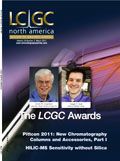
New Method Explored for the Detection of CECs in Crops Irrigated with Contaminated Water
April 30th 2025This new study presents a validated QuEChERS–LC-MS/MS method for detecting eight persistent, mobile, and toxic substances in escarole, tomatoes, and tomato leaves irrigated with contaminated water.
University of Tasmania Researchers Explore Haloacetic Acid Determiniation in Water with capLC–MS
April 29th 2025Haloacetic acid detection has become important when analyzing drinking and swimming pool water. University of Tasmania researchers have begun applying capillary liquid chromatography as a means of detecting these substances.
Prioritizing Non-Target Screening in LC–HRMS Environmental Sample Analysis
April 28th 2025When analyzing samples using liquid chromatography–high-resolution mass spectrometry, there are various ways the processes can be improved. Researchers created new methods for prioritizing these strategies.

.png&w=3840&q=75)

.png&w=3840&q=75)



.png&w=3840&q=75)



.png&w=3840&q=75)














